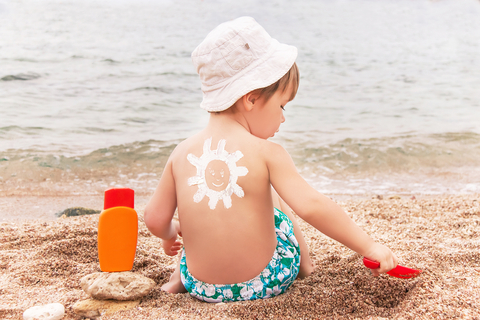Summer is in full swing here in Australia and it seems to be one hot, stinky day after another! For most of us this means heading to the beach, more time outdoors, jamming it up at festivals and if you’re not careful, dreaded sunburn! Getting sun burnt is nasty, but is sunscreen even nastier?
Because we’ve made a commitment to live a no tox/low tox lifestyle, I made it my business to research sunscreens and check out if what we had in the cupboard was going to fit into our new way of living. Boy was I shocked when I checked out the ingredients. I was even more dismayed when I realised what the ingredients were linked to! Surely our top brands of sunscreen (I looked at the Top 13 products in Australia) cannot possibly contain chemicals linked to provoking cancer cells, the very thing it is supposed to protect us from! Well it seems so, even though there is still disagreement on whether this is the case. The way I see it is even if there is a little inkling of doubt this is enough to initiate alarm bells and look for a safer alternative.
So what should you be looking out for and what should you be avoiding in your sunscreen?
- Oxybenzone (benzophenone-3; 2 hydroxy-4-methoxybensophenone):
What is oxybenzone – its primary function in sunscreen is to absorb UVA ultra-violet rays. It’s derived from benzene, which is a natural compound naturally occurring in crude petroleum. It has been found to significantly penetrate the skin layers and has been detected in both human urine and breast milk.
What are the potential effects – produces damaging reactive oxygen species when exposed to sunlight (free radicals), linked to endocrine disruption, suspected kidney and liver toxicity, suspected environmental and wildlife toxicity. Exposure to this compound can also cause contact dermatitis, irritation and uticaria. - Camphor Derivatives (4-methylbenzylidene camphor or 4MBC):
Concerns have been raised over 4MBC due to evidence indicating that this derivative may be an endocrine disruptor linking it to hypothyroidism. It is potentially very persistent as well as being bioaccumulative in our environment. - Cinnamates (Octyl Methoxycinnamate; isoamyl-p-methoxycinnamte; cinoxate):
Primarily used in sunscreen as a UV absorber and UV Filter, cinnamates are suspected endocrine disruptors as well as causing wildlife and environmental toxicity. Shown to penetrate the skin layers, it may be accumulative in the body. In an in vitro study conducted on mice cells, Octyl Methoxycinnamate when added to Ethyl Alcohol was found to kill 50% of the cells (only 10% of cells were killed when only Ethyl Alcohol was used alone). Linked to causing skin irritations and allergies. - Dibenzoylmethanes (Avobenzone; 4-t-butyl-4′-methoxydibenoylmethane):
Avobenzone may result in the production of free radicals when exposed to UV light which may result in DNA damage. Once exposed to UV light, it becomes unstable and breaks down into other chemicals such as benzaldehyde, acetophenone, benzoic acid to name a few. Avobenzone may also cause contact allergies. - Octocrylene:
A UV filter/absorber that is related to Cinnamates, may result in the production of free radicals upon exposure to the sun. Shown to penetrate the skin and is a persistent chemical that is bioaccumulative in wildlife. - Fragrance:
That wonderful alluring smell that captivates us and draws us in. Found in so many of our products these days from cosmetics through to cleaning products. Around 95% of chemicals used in fragrances are petroleum derived synthetic compounds and are one of the most common causes of allergies and skin irritations.
What I feel most uncomfortable about is applying these products to my skin when firstly I’m not able to pronounce any of the ingredients, nor do I know exactly what they are. Add these to the chemical soup that already exists in my body due to environmental toxins I can’t control, and I find this really concerning. It’s super important to understand that none of the chemicals registered that are permitted to be used in our products, have been tested en masse. In other words, we have not a clue as to how they react together inside our bodies or environment, we are merely guinea pigs just waiting to find out.
So the solution to this was I needed to find the most low toxic sunscreen out there. I searched far and wide and was able to find two brands that stood out. Eco Logical Skin Care and Wotnot. Though not absolutely perfect (there are no perfect brands out there), these were certainly the best available at the time.
Care and Safety:
I have a little motto that I always repeat to my children, “Between 10 and 3 sit under a tree”. Even when you are protected by sunscreen, it’s really important to avoid the midday sun which in my opinion in Australia is at it’s most harsh between 10am and 3pm. Never endure prolonged sun exposure. I would always keep children under 12 months of age, completely out of direct sunlight and wear protective clothing as well as a hat and sunglasses. Even sunscreens that have the highest sun protection factors will not provide 100% protection against UV/radiation and every case of sunburn does damage the skin permanently. Always, always reapply your sunscreen regularly (1-2 hours to ensure you are protected, particularly after swimming. Over exposure to the sun does cause serious health threats. Having said that, under exposure to the sun also causes serious health threats so be vigilant about your exposure.
Happy Summer Days!


